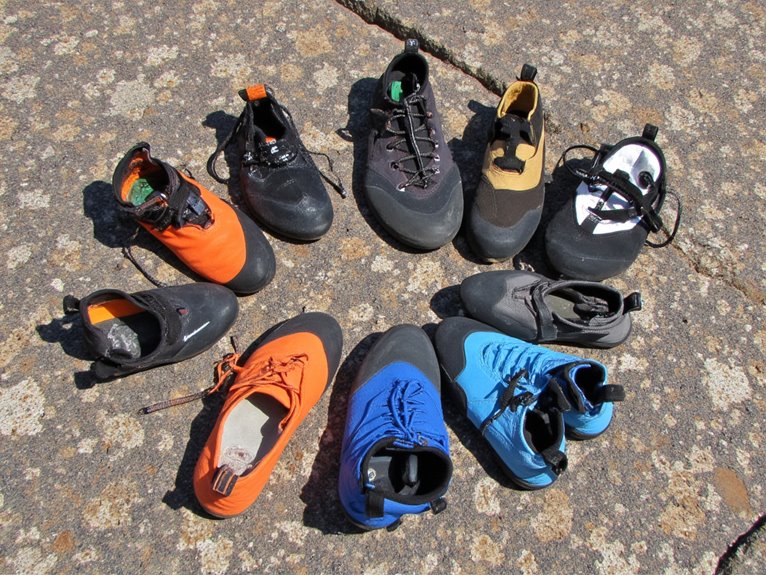Why Are Backpacks Not Waterproof?
Backpacks aren't completely waterproof due to the delicate balance of material limitations, design compromises, and performance tradeoffs. Manufacturers face a tough task: creating a backpack that's both water-resistant and portable. Fully waterproof backpacks would be bulky and heavy, defeating their purpose. Prioritizing water resistance means sacrificing comfort, durability, and functionality. Even high-end backpacks can't guarantee complete waterproofing. It's essential to understand the differences between water resistance and waterproofing when making purchasing decisions. As we delve into the complexities of backpack design, one thing becomes clear: the perfect backpack is a balancing act – and there's more to the story.
We are supported by our audience. When you purchase through links on our site, we may earn an affiliate commission, at no extra cost for you. Learn more. Last update on 18th December 2025 / Images from Amazon Product Advertising API.
Water Resistance Vs Waterproofing
Most backpacks touted as 'waterproof' are, in reality, only water-resistant, and understanding the distinction between these two terms is essential for making informed purchasing decisions.
While both terms imply protection from water, they have vastly different implications.
Waterproofing implies a complete seal, where water cannot penetrate under any circumstances.
Water-resistance, on the other hand, means the material can withstand some water exposure, but not indefinitely.
In practice, this means a water-resistant backpack can keep your gear dry in light rain or accidental splashes, but may fail in more extreme conditions, such as immersion or prolonged exposure.
Don't be misled by marketing claims – know the difference to choose the right backpack for your needs.
Material Limitations and Choices
In regards to water-resistant backpacks, the material used can greatly impact their ability to keep your gear dry, and understanding the limitations of these materials is key to making informed purchasing decisions.
When it comes to material choices, manufacturers face a delicate balance between water resistance, durability, and weight.
The following three key material limitations should be taken into account:
- Water-repellent coatings: These coatings can wear off over time, compromising the backpack's water-resistance.
- Water-resistant membranes: While effective, these membranes can be heavy, stiff, and prone to punctures.
- Breathable fabrics: These fabrics prioritize airflow over water resistance, making them less effective in heavy rain or immersion.
Weight and Packing Volume Tradeoffs
In backpack design, every ounce counts – and every cubic inch, too.
The eternal conundrum is this: do you prioritize packing density to fit all your essentials, or do you opt for lightweight materials that compromise on storage space?
As we weigh the pros and cons, it's clear that finding the perfect balance is a delicate art.
Packing Density Matters
Optimizing packing density is vital, as every ounce of weight and inch of volume counts when you're lugging your gear around, and finding the sweet spot between the two can make all the difference in your backpacking experience.
A well-packed backpack can be the difference between a comfortable hike and a miserable one.
1. Pack multi-use items: Choose gear that serves multiple purposes to reduce overall weight and volume.
2. Roll your clothes: Rolling your clothes instead of folding them can help reduce wrinkles and save space in your pack.
3. Use compression bags: Compression bags can help compress your gear, making the most of your backpack's space.
Lightweight Materials Sacrifices
Ultralight backpackers often sacrifice durability and water resistance for the sake of shaving precious ounces and inches from their packs, a tradeoff that can leave them vulnerable to the elements.
Lightweight materials, while a boon for hikers, compromise on water resistance. To achieve featherlight constructions, manufacturers use thinner, more porous fabrics that allow moisture to seep in.
This weight-packing volume tradeoff is a delicate balance, as a pack that's too light may not withstand harsh weather.
The result? A backpack that's more prone to water ingress. While shaving grams is essential for thru-hikers, the quest for lightweight gear can lead to a false sense of security, leaving backpackers caught in the rain – quite literally.
Cost and Price Point Considerations
In the domain of backpacks, the age-old adage 'you get what you pay for' rings particularly true, as a higher price point often correlates with increased water resistance, but not necessarily complete waterproofing.
In terms of water resistance, you're likely to get what you pay for. A budget-friendly backpack may not have the same level of water protection as a high-end one.
Budget-friendly options: You'll often find basic water-resistant coatings or treatments, but don't expect complete waterproofing.
Mid-range options: You'll see more advanced water-resistant materials and construction, but still, no guarantees of complete waterproofing.
High-end options: You'll often find advanced waterproof materials and construction, but even then, no guarantees of complete waterproofing.
Balancing Durability and Breathability
In the domain of backpack design, finding the perfect balance between durability and breathability is a delicate tightrope act, as one often comes at the expense of the other.
A waterproof backpack may be impermeable to rain, but it's likely to be a sweaty, clammy experience for the wearer.
On the other hand, a breathable backpack may keep you cool and dry, but it may not withstand the elements.
Manufacturers must walk a fine line, using materials and design elements that balance these competing demands.
It's a tricky puzzle, but one that's essential to creating a functional, comfortable, and reliable backpack.
Moisture Management Systems Fail
Moisture management systems, touted as the solution to backpackers' prayers, often prove to be nothing more than a false promise, unable to effectively keep gear dry in even moderately wet conditions. These systems, which claim to wick away moisture and keep your gear dry, often fall short of their promises.
There are three reasons why moisture management systems fail:
- Material limitations: The materials used in these systems can only handle so much moisture before becoming saturated, rendering them useless.
- Design flaws: Poorly designed systems can create pockets of moisture, allowing water to seep in and ruin your gear.
- Real-world conditions: In the midst of a torrential downpour or wading through a river, even the best moisture management systems can't keep up.
It's time to rethink our reliance on these systems and investigate other solutions to keep our gear dry.
Testing and Certification Standards
Current testing and certification standards, touted as the benchmark for waterproofing, are often as leaky as the backpacks they're supposed to protect.
These standards, such as IPX ratings and waterproofing certifications, can be misleading, as they're often based on controlled laboratory tests that don't accurately simulate real-world conditions.
Additionally, manufacturers may cherry-pick testing protocols to achieve a desired rating, rather than submitting their products to rigorous, real-world testing. Furthermore, manufacturers may also manipulate testing protocols to achieve a desired rating, rather than submitting their products to rigorous, real-world testing.
As a result, backpacks can still leak or fail in actual use, despite boasting impressive-sounding certifications.
It's high time to re-examine these standards and develop more realistic, practical testing protocols that reflect the harsh realities of outdoor adventures.
Real-World Usage and Expectations
Five minutes into a torrential downpour, the reality of a 'waterproof' backpack's limitations becomes painfully clear. The water-repellent coating is no match for the relentless rain, and you're left with a soggy mess. Real-world usage reveals that even the most touted waterproof backpacks have their limits.
Three common scenarios where expectations meet reality include:
- Rainy commutes: That 'waterproof' backpack won't keep your laptop dry when you're stuck in a downpour.
- Beach trips: Sand and water can sneak into the seams, ruining your snacks and sunscreen.
- Hiking in wet conditions: Moisture can seep in through zippers, pockets, and seams, leaving your gear damp.
The gap between marketing claims and real-world performance can be frustrating. It's essential to understand the limitations of your backpack and plan accordingly.
Design Priorities and Compromises
Most backpack designers face a delicate balancing act, sacrificing some level of water resistance to prioritize features like lightweight materials, stylish aesthetics, and extensive storage capacity.
This compromise is necessary, as making a backpack fully waterproof would require bulky and heavy materials, defeating the purpose of a portable bag.
Designers must weigh the importance of water resistance against other essential factors, such as comfort, durability, and functionality.
By doing so, they can create a backpack that checks most boxes, even if it's not entirely waterproof.
After all, who wants to lug around a heavy, plastic-like bag that's more suited to carrying scuba gear than laptops and lunch?


